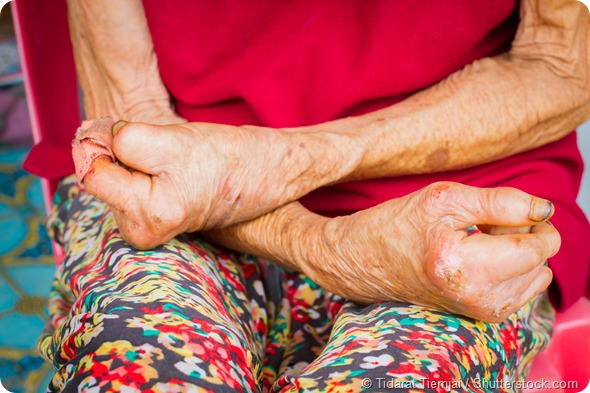Leprosy, or Hansen’s disease, was reported more than 3000 years ago. It was interpreted as a curse of the gods, or the punishment of sin, or a hereditary disease.

It was in 1873, over a hundred years ago, that the Norwegian physician Gerhard Hansen saw the leprosy bacillus under the microscope and proved that leprosy was an infectious disease and not a curse. As a tribute to this great researcher, the disease is now named after him. The term hanseniasis was first put forward by Abraao Rotberg in 1967, with the additional purpose of taking the sting out of the diagnosis.
Despite this discovery, lepers continued to be treated primarily by isolation in leper camps far from settled human habitations.
Leprosy originated either in Africa or Asia, but reached Europe through the conquering armies of Alexander the Great, circa 300 BC. It ravaged Europe and the Middle East during the Dark Ages, until approximately 1870.
During this period, the overcrowding, poor sanitation, and malnutrition of the poor people who made up the majority of the population contributed to a high incidence of leprosy. Improved socioeconomic conditions led to a dramatic fall in the number of new cases. Leprosy reached South America from colonial invaders, mostly through African slaves brought into the country.
Throughout much of world history, leprosy was incurable and disfiguring, which led to the feeling of horror and fear with which lepers were regarded. Chaulmoogra oil injection was one of the few treatments which benefited at least some patients. However, its efficacy over the long term was unproved, and the injections were quite painful.
In 1921, the U.S. Public Health Service set up a center for the study and treatment of leprosy in Carville, Louisiana, which became known as “Carville.” It was both a premier leprosy research center and a residential unit for leprosy patients, who often were unwelcome elsewhere.
What Happens When You Get Leprosy?
A great step forward was made with the discovery in 1940, at Carville, that sulfones were effective in treating leprosy, so much so that isolation was no longer necessary as the patient quickly became non-contagious. Yet quarantine in leper colonies was abolished by official decree only as late as the 1960s.
Despite this decision, most patients around the world remained confined to leprosy colonies. Sulfones had the serious drawback that a course of several painful injections were required to treat leprosy.
Dr. Cochrane of Carville made the groundbreaking discovery in the 1950s, that oral sulfones were equally effective. Its effects seemed little short of miraculous, but unfortunately, drug resistance soon set in, rendering the drug useless when administered alone.
This was followed by more intense research resulting in the announcement of guidelines for multi-drug therapy (MDT) by the World Health Organization in 1981. The first trials were held on the historic island of Malta around 1970 and have been in use throughout most of the world since then. The duration of therapy may last 6-24 months depending on the severity and type of clinical manifestation.
At present, much progress has been made on rehabilitation and plastic surgery to restore cosmetic and functional normalcy for leprosy patients who have lost parts of their faces or limbs to leprosy. Early diagnosis and treatment with the MDT remains the first choice to cure leprosy and prevent long-term damage to nerves, the resulting deformity and disability, and cut the chain of transmission.
Vaccines against the bacillus are still under development. Active efforts are also focused on developing ways to diagnose individuals and communities at high risk of contracting the disease from contacts.
References
- https://web.stanford.edu/group/parasites/ParaSites2005/Leprosy/history.htm
- https://www.ncbi.nlm.nih.gov/pmc/articles/PMC4008049/
- https://www.ncbi.nlm.nih.gov/pmc/articles/PMC4458930/
- https://www.hrsa.gov/hansensdisease/history.html
Further Reading